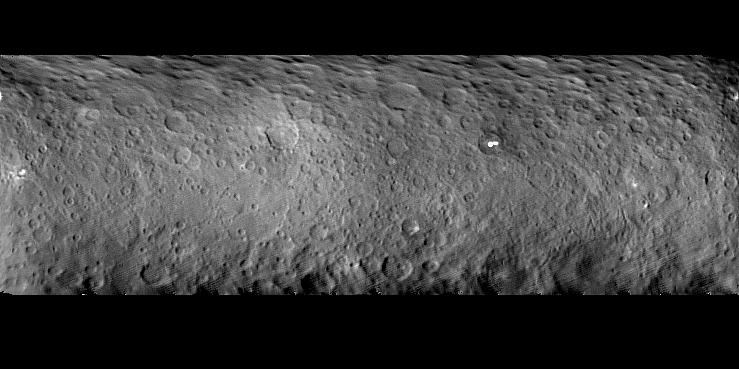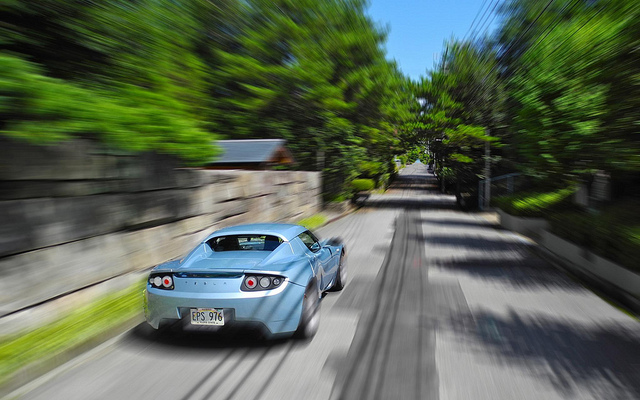
Do Not Blog About Feature #5
Earlier this month, at the Lunar and Planetary Science Conference, Adreas Nathues, the leader of the Dawn Framing Camera team, presented data about the “bright spot” (known simply as feature #5) that’s been seen on the surface of dwarf planet Ceres. Turns out, now that the topographic data have been recorded, it looks as though the bright spot can be seen above the rim of the crater in which it sits. He thinks this means it’s a plume of some sort, although I suppose it doesn’t entirely rule out “tall and glassy alien city” either. But more interesting was the way in which it was presented: he began by asking bloggers not to write about it. Of course, the writers from Nature and Science both immediately blogged about it, which doesn’t so much “let the cat out of the bag” as “dump the cat out and burn the bag behind it.” In light of this, Emily Lakdawalla at the Planetary Society has a great post about the weirdness of embargoes and blogging which I suggest you read. The idea of an active geology on Ceres is pretty exciting, but we won’t know for sure until Dawn gets in for a closer look later this year. In the meantime, here’s a roundup of all the latest on Ceres, also by Emily Lakdawalla.

Grabbing an Asteroid (or a Piece of One)
Two weeks ago I expressed my doubts about the asteroid retrieval mission that Orion’s first manned mission is meant to intercept in lunar orbit in 2021. This week they’ve announced a change to the mission: instead of retrieving a whole asteroid for astronauts to rendezvous with, now they’re thinking or grabbing a largeish asteroid rock, like a boulder, and getting that into orbit around the moon instead. The robotic part of the mission would involve launching around 2019, meeting up with an asteroid, taking lots of photos and selecting a boulder, and grabbing it with the robotic spacecraft. Then it would hand around the asteroid for around five years, trying to use the gravity of the boulder to nudge the asteroid ever so slightly and change its orbit, a technique which, if successful, would prove very useful in the event that we discover an asteroid interested in annihilating life on Earth. After that, it’ll fly back to the moon, where in roughly 2025 NASA will send a team of astronauts in the Orion to meet up with it, study it, and retrieve samples before coming home. That’s a few years later than the original 2021 timetable, but given the cost constraints I suppose it’s good to know they’re still trying. Check out SpaceFlight Now or Ars Technica for more.

Another Upgrade
The Tesla Model S will be getting an interesting software upgrade this summer, according to billionaire entrepreneur and man for all seasons Elon Musk. In an announcement last week, Musk said that the upgrade will allow the sedan to drive itself — at least a little. Think of it as an update to cruise control, one where it takes over the steering, too. Now, unfortunately for Model S owners keen to try it out, they may have to wait — it’s not exactly certain that self-driving cars are, well, legal just yet. But Musk says there isn’t a law against it, at least not yet, so I guess we’ll see how things come to rest over the next couple of years. Check out Gizmodo for more on the story.
And in related news, Mercedes’s new self-driving technology testbed (they don’t like the term “concept car”) has made the rounds recently, and it’s pretty darn cool. Check out Alex Davies’s post in Wired for more: “The Mercedes Robo-Car That Made Me Want To Stop Driving.”
Taking a Stand Over Peer Review
Mark Maslin, an editor for the journal Nature Scientific Reports, resigned this week over a new plan by the journal to allow authors to pay for a quicker review process by a private company. If that sounds a little strange to you, it probably should. The unbiased peer review process is the basis on which the whole academic infrastructure sits, and the introduction of a two-tiered system in which larger labs (or labs with deeper pockets) could get their work reviewed faster for cash doesn’t sit right with a lot of people. While Nature Publishing Group maintains that “the introduction of this service has no bearing on [their] editorial decision process,” it’s hard to see how a fast-track for-pay option where a privately-paid set of reviewers are used is likely to maintain the same standards. Check out AAAS Science Insider for more.
Bigger, Faster, Cheaper
This week two more companies joined Samsung in announcing they’ll be using something called 3D-NAND technology in the manufacture of their solid state drives. Both Toshiba and Intel announced this week that they’ll be selling the tech, which promises faster, cheaper, and more spacious hard drives. As Engadget has it, “you’ll soon get 10TB SSDs,” which is actually a little ridiculous when you think about the fact that all of wikipedia is around 10GB. Wired has more on the story.
Seeing Spacefarers
A new article posted to arxiv.org this month, “Limits and Signatures of Relativistic Spaceflight,” has added a new dimension to discussions about high-speed travel in the galaxy. Thing, is, when you get going really really fast, you start to run into a lot of things. And at those speeds, even tiny things — like Cosmic Microwave Background photons — have a big impact. The study suggests that there’s probably an upper limit on how fast anything can go at relativistic speeds, and that anything at relativistic speeds should give off a fairly unnatural looking signature that we could probably see from Earth. Check out the paper (which, aside from the complex math, is surprisingly readable) at arxiv.org.
Best of the Rest
Like every week, there were more stories than I have time to share with you in detail, so here’s some of the rest in point-form:
- Looks like something big (really big) hit Australia a long, long time ago. We’re just not sure exactly when.
- Scientists are working on rolls of invisibility tape. Predictably, you can’t buy any just yet.
- Boeing just filed a patent for a plasma shield. Yeah, you read that right.
- Jupiter might’ve really screwed with the initial formation of the solar system.
- NASA’s still working on just where to send New Horizons after Pluto. They’re down to two (if they get the funding).
- Elon Musk dropped SpaceX’s photos into the public domain, which is awesome, and
- Here’s an animation of dinosaurs that really gets the name — “Terrible Lizards” — right.
And before I go, here’s a trip down memory lane to send you off — they’re rebooting Astro Boy. I can’t wait.
